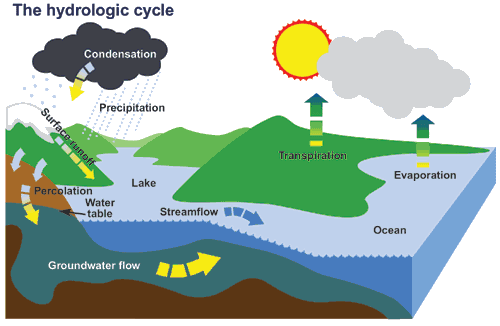Being an environmental scientist is sometimes like detective work. When there is something wrong in a watershed we have to piece together incomplete information and try to decide what the possible causes of problems or improvement we are finding might be. This is because information on water quality is expensive to collect and therefore is not collected all the time or at every place. This is what you will do for your projects. To get you started, we have assembled some background information on watersheds and data on one watershed so that you can practice being a watershed detective.
Conceptual Model of Water Pollution
As an example, we will be exploring what happens to water quality and the flow of water in streams as a result of human activities. We can begin to think about this system by reviewing the hydrologic cycle and the concept of a watershed. A watershed is the area of land that forms the drainage system for a stream or lake. Any water that falls on that land surface and flows off the land will end up in that stream. However, not all water that falls on a watershed actually ends up in the stream or lake. The illustration of the hydrologic cycle shown below shows that many pathways can occur.

Source: https://www.canada.ca/en/environment-climate-change/services/water-overv...
Rainfall coming toward the earth can evaporate back into the atmosphere, either on its way down or after it lands. It can also be captured on the leaves of plants or rooftops where it evaporates. Water reaching the ground infiltrates into the surface soil and, from there, into the ground water. Whatever does not percolate runs off the surface toward the nearest body of water. The local streams and lakes also receive water from the ground water between rain storms. Water from the soil can also continue to evaporate back into the atmosphere or transpire through the leaves and stems of plants.
When people change the land surface for agriculture, housing, roads, and businesses, they create major changes in this cycle. They alter the land's surface with pavement and by compacting soils with tractors and livestock. This reduces the amount of rainfall which infiltrates and increases the amount that runs off. The water flowing over the surface picks up pollutants and transports them to streams and lakes. At the same time, water is withdrawn for cooking, bathing, and industrial activities and discharged as treated or untreated wastes directly into the stream. The health of the stream then declines.